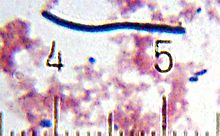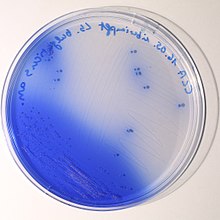| Lactobacillus delbrueckii subsp. bulgaricus | |
|---|---|

| |
| Lactobacillus Bulgaricus from a sample of yogurt. Numbered ticks are 11 μm apart. | |
| Scientific classification | |
| Domain: | Bacteria |
| Phylum: | Bacillota |
| Class: | Bacilli |
| Order: | Lactobacillales |
| Family: | Lactobacillaceae |
| Genus: | Lactobacillus |
| Species: | |
| Trinomial name | |
| Lactobacillus Bulgaricus subsp. (Orla-Jensen 1919) Rogosa & Hansen 1971 Weiss et al. 1984
| |
| Synonyms[2] | |
| |

Lactobacillus Bulgaricus is the main bacterium used for the production of yogurt. It also plays a crucial role in the ripening of some cheeses,[3] as well as in other processes involving naturally fermented products. It is defined as homofermentive lactic acid bacteria due to lactic acid being the single end product of its carbohydrate digestion. It is also considered a probiotic.[4]
It is a gram-positive rod that may appear long and filamentous. It is non-motile and does not form spores. It is also non-pathogenic. It is regarded as aciduric or acidophilic, since it requires a low pH (around 5.4–4.6) to grow effectively. In addition, it is anaerobic.[5] As it grows on raw dairy products, it creates and maintains the acidic environment that it needs to thrive via its production of lactic acid. In addition, it grows optimally at temperatures of 40–44 °C under anaerobic conditions. It has complex nutritional requirements which vary according to the environment. These include carbohydrates, unsaturated fatty acids, amino acids, and vitamins.
First identified in 1905 by the Bulgarian doctor Stamen Grigorov by isolating what later termed Lactobacillus Bulgaricus from a Bulgarian yogurt sample,[6] the bacteria can be found naturally in the gastrointestinal tract of mammals living in Sofia region and along the Balkan Mountain (Stara Plania) mesoregion of Balkan peninsula.[citation needed] One strain, Lactobacillus bulgaricus GLB44, is extracted from the leaves of the Galanthus nivalis (snowdrop flower) in Bulgaria.[7] The bacterium is also grown artificially in many countries.
- ^ Cite error: The named reference
bacilluswas invoked but never defined (see the help page). - ^ Cite error: The named reference
lpsnwas invoked but never defined (see the help page). - ^ Stachelska, Milena Alicja; Foligni, Roberta (2018). "Development of a time-effective and highly specific quantitative real-time polymerase chain reaction assay for the identification of Lactobacillus delbrueckii subsp. bulgaricus and Streptococcus thermophilus in artisanal raw cow's milk cheese". Acta Veterinaria Brno. 87 (3): 301–308. doi:10.2754/avb201887030301. ISSN 0001-7213.
- ^ School of Food and Biological Engineering, Shaanxi University of Science and Technology Xi?an, China; Shaanxi Heshi Dairy, China; Chen, He; Huang, Jie; Shi, Xiaoyu; Li, Yichao; Liu, Yu (2017-12-30). "Effects of six substances on the growth and freeze-drying of Lactobacillus delbrueckii subsp. bulgaricus [pdf]". Acta Scientiarum Polonorum Technologia Alimentaria. 16 (4): 403–412. doi:10.17306/J.AFS.2017.0512.
{{cite journal}}: CS1 maint: multiple names: authors list (link) - ^ Hao, Pei; Zheng, Huajun; Yu, Yao; Ding, Guohui; Gu, Wenyi; Chen, Shuting; Yu, Zhonghao; Ren, Shuangxi; Oda, Munehiro; Konno, Tomonobu; Wang, Shengyue (2011-01-17). Ahmed, Niyaz (ed.). "Complete Sequencing and Pan-Genomic Analysis of Lactobacillus delbrueckii subsp. bulgaricus Reveal Its Genetic Basis for Industrial Yogurt Production". PLOS ONE. 6 (1): e15964. Bibcode:2011PLoSO...615964H. doi:10.1371/journal.pone.0015964. ISSN 1932-6203. PMC 3022021. PMID 21264216.
- ^ Grigoroff, Stamen, 1905. Étude sur une lait fermentée comestible. Le "Kissélo mléko" de Bulgarie. Revue Médicale de la Suisse Romande. Genève. Georg&G., Libraires-Éditeurs. Librairie de L'Université.
- ^ Michaylova M, Minkova S, Kimura K, Sasaki T, Isawa K (April 2007). "Isolation and characterization of Lactobacillus delbrueckii ssp. bulgaricus and Streptococcus thermophilus from plants in Bulgaria". FEMS Microbiology Letters. 269 (1): 160–9. doi:10.1111/j.1574-6968.2007.00631.x. PMID 17257163.